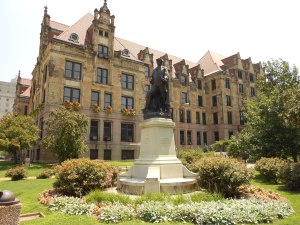The story so far: On November 28, 1939, 75 years ago, a thick, black smoke covered St. Louis, turning day into night, snarling traffic and angering and shocking residents. A Smoke Elimination Committee was created and it met through January and into February sorting out its limited options for finagling cleaning the city’s air. Its report in late February proposed that all residents and businesses buy more expensive fuel that caused less pollution. A public hearing on March 26 drew 400 people with broad support except from the coal industry.
By Bob Wyss
As support grew for the city’s plan to clean its air the Board of Alderman scheduled April 5 to finally act.
There seemed to be little suspense about the outcome. A majority of board members indicated they would vote for the necessary ordinance and only two were considering what amounted to minor amendments.
Fire Chief Lawrence Cornoyer said he believed that the measures would reduce the number of fires and injuries. The ordinance encouraged the use of mechanical stokers which Cornoyer said would be an improvement because people sometimes fed too much coal into a furnace. When that happened the fire could flare and spread beyond the fire box, and cause a house fire.
The changes could not come fast enough for some people. One local physician was so upset by the state of the city’s air pollution that he had a sign fashioned, which he attached above the license plate of his automobile. Above the Missouri – 1940 designation on the plate were the words “Soot Louis, Mo.”
The doctor, who was not named, explained: “It was a brainstorm of mine to focus attention on the smoke situation, but some of my friends say it’s a harsh criticism of our city and I’m afraid it has been taken in the wrong light.”
The doctor said he gave some of the signs to friends, and tried to sell others at gas stations to defray his costs, but he had finally given up.
Meanwhile city officials were fielding questions about a new statue at Aloe Plaza. Called the Meeting of the Waters, it featured 14 nude figures. Some were asking if there had been complaints about the statues because they were still boarded up. City Engineer William Becker said the barriers were up only to protect them from the weather. But he did worry what might happen next winter.
“Unless we do something about it,” he said, “they’ll turn coal black, just like all the other statuary in St. Louis.”

